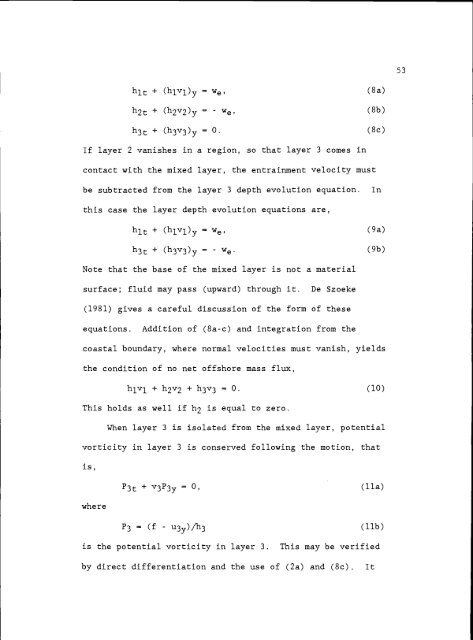Observations and Modelling of Fronts and Frontogenesis
Observations and Modelling of Fronts and Frontogenesis
Observations and Modelling of Fronts and Frontogenesis
You also want an ePaper? Increase the reach of your titles
YUMPU automatically turns print PDFs into web optimized ePapers that Google loves.
hit + (hivi) = We, (8a)<br />
h2t + (h2v2) We, (8b)<br />
h3t + (h3v3)y 0. (8c)<br />
If layer 2 vanishes in a region, so that layer 3 comes in<br />
contact with the mixed layer, the entrainment velocity must<br />
be subtracted from the layer 3 depth evolution equation. In<br />
this case the layer depth evolution equations are,<br />
hit + (hlvl)y We, (9a)<br />
h3t + (h3v3)y We. (9b)<br />
Note that the base <strong>of</strong> the mixed layer is not a material<br />
surface; fluid may pass (upward) through it. De Szoeke<br />
(1981) gives a careful discussion <strong>of</strong> the form <strong>of</strong> these<br />
equations. Addition <strong>of</strong> (8a-c) <strong>and</strong> integration from the<br />
coastal boundary, where normal velocities must vanish, yields<br />
the condition <strong>of</strong> no net <strong>of</strong>fshore mass flux,<br />
h1v1 + h2v2 + h3v3 = 0. (10)<br />
This holds as well if h2 is equal to zero.<br />
When layer 3 is isolated from the mixed layer, potential<br />
vorticity in layer 3 is conserved following the motion, that<br />
is,<br />
where<br />
3t + v3P3y = 0,<br />
(ila)<br />
P3 = (f u3y)/h3 (llb)<br />
is the potential vorticity in layer 3. This may be verified<br />
by direct differentiation <strong>and</strong> the use <strong>of</strong> (2a) <strong>and</strong> (8c). It<br />
53















